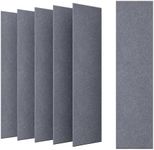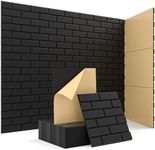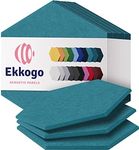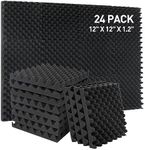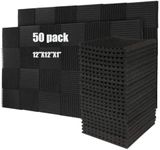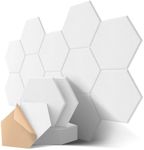Buying Guide for the Best Soundproof Panels
Choosing the right soundproof panels can make a big difference in how much unwanted noise you block out or how well you control sound within a room. Whether you want to reduce echoes in a home studio, quiet down a noisy office, or create a peaceful bedroom, understanding the key features of soundproof panels will help you make a smart choice. It's important to match the panel's properties to your specific needs, such as the type of noise you're dealing with and the space where you'll install them.MaterialThe material of a soundproof panel determines how well it can absorb or block sound. Common materials include foam, fiberglass, mineral wool, and fabric-wrapped panels. Foam panels are lightweight and good for reducing echoes, while fiberglass and mineral wool are denser and better at blocking outside noise. If you want to improve the sound quality inside a room, foam or fabric panels are often enough. For blocking noise from outside or between rooms, denser materials like fiberglass or mineral wool are more effective. Think about whether you need to control sound within a space or keep noise out, and choose the material accordingly.
ThicknessThickness refers to how deep the panel is, usually measured in inches or centimeters. Thicker panels generally absorb lower frequencies better, while thinner panels are more effective for higher frequencies. If you're dealing with deep, bass-heavy sounds (like music or machinery), thicker panels will help more. For general echo reduction or speech clarity, thinner panels may be sufficient. Consider the type of noise you want to manage and the available space on your walls when deciding on thickness.
NRC (Noise Reduction Coefficient)NRC is a rating that shows how much sound a panel can absorb, on a scale from 0 (no absorption) to 1 (total absorption). A higher NRC means the panel is better at soaking up sound and reducing echoes. For spaces where you want to minimize echo and improve clarity, like studios or conference rooms, look for panels with a higher NRC (0.7 and above). For basic noise control in less critical areas, a lower NRC may be enough. Match the NRC rating to how much sound control you need in your space.
Size and ShapeSoundproof panels come in various sizes and shapes, such as squares, rectangles, or even decorative patterns. Larger panels cover more area and can be more effective, but smaller panels offer more flexibility in placement. The shape can also affect how sound is absorbed and how the panels look in your room. If you have a large area to cover or want a uniform look, bigger panels or matching shapes work well. For targeted sound control or creative designs, mix and match smaller panels or different shapes.
Installation MethodHow you attach the panels to your walls or ceilings matters for both effectiveness and convenience. Some panels use adhesive strips, others have hooks, and some require more permanent mounting. If you rent or want to avoid wall damage, look for panels with removable adhesives or easy-to-move options. For long-term or heavy-duty soundproofing, more secure installation may be better. Think about your space, whether you might want to move the panels later, and how much effort you're willing to put into installation.
Fire Safety RatingFire safety ratings indicate how resistant the panels are to catching fire. This is especially important in public spaces or areas with electrical equipment. Panels with a higher fire safety rating provide extra peace of mind. If you're installing panels in a home studio, office, or any place where safety is a concern, check for fire-resistant certifications. Always consider the safety requirements of your building or local regulations when making your choice.


